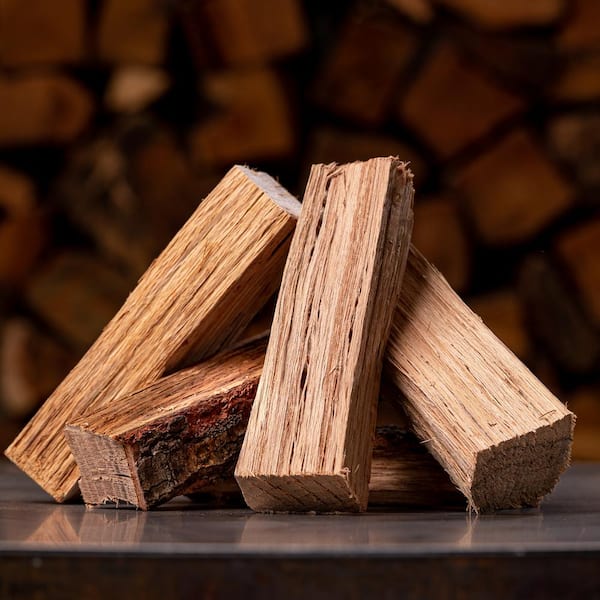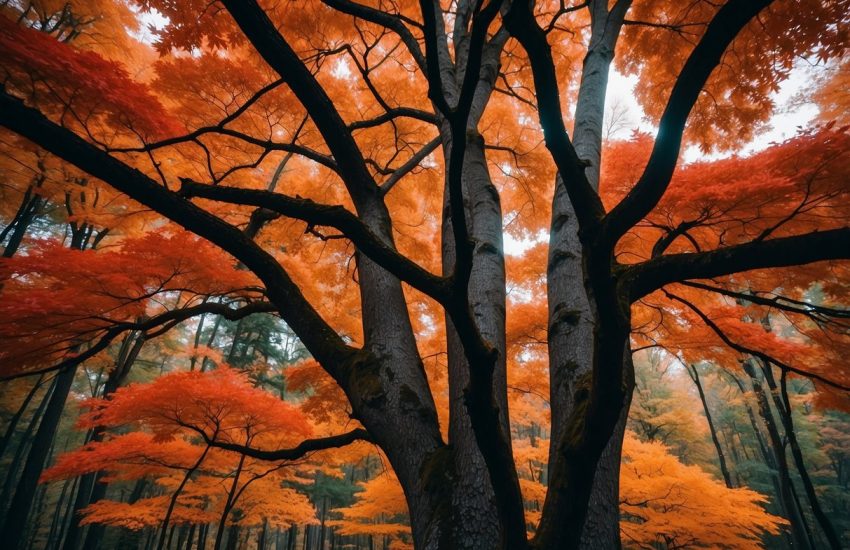Is Hickory Good for Firewood – Burning Characteristics of Hickory Firewood
Hickory is one of the best woods you can burn in your fireplace. It has a high heat content and fumes that repel insects. When Hickory is burned, it produces an aroma that some people find pleasantly woodsy. Hickory wood is also dense and difficult to split, so it’s best to use a heavy-duty axe or maul. If you do manage to split it, Hickory makes excellent kindling. In fact, fatwood, which is partially decomposed hickory heartwood, is often sold as a fire starter.

Characteristics of Hickory Firewood
Hickory trees are an important part of North American forests. There are 16 species of Hickory, all in the genus Carya. These trees are native to the eastern and central United States and parts of Canada and Mexico. Hickories are generally large trees, with most species reaching heights of 20-40 meters (65-130 feet). They have thick, rough bark and large, pinnately compound leaves. The hickory trees’ fruits are edible nuts encased in a hard shell. The wood is hard and dense, making it resistant to wear and tear. Hickory is also a very flexible wood, meaning that it can be used for various purposes. For example, Hickory is often used in manufacturing furniture, flooring, and tool handles. The distinctive grain pattern of hickory wood makes it a popular choice for cabinets and other woodworking projects. In addition to its strength and flexibility, Hickory is also prized for its unique flavor. Hickory makes one of the best firewood producing a lot of heat, and its unique aroma, when burned, makes it well suited for smoking meat when barbecuing.
Types of Hickory That Can Be Used For Firewood
Hickory is prized for its heat output and long-lasting burn. While all types of Hickory make excellent firewood, some species are better suited for this purpose than others. The three most popular types of Hickory for firewood are shagbark, bitternut, and pignut. Shagbark hickory is the most common type of Hickory used for firewood. It is characterized by its thick, cork-like bark that peels away in long strips. Bitternut hickory is another popular type of Hickory for firewood. It is distinguished by its small, round nuts that taste bitter. Pignut hickory is the third most common type of Hickory used for firewood. It is known for its large, edible nuts favored by animals such as squirrels and chipmunks. Whichever type of Hickory you choose, you can be sure that it will make a great addition to your fireplace or wood stove.
Seasoning Hickory Firewood
Seasoning firewood is an important step in the process of preparing it for use. Seasoned wood is easier to ignite, burns more evenly, and produces less smoke than unseasoned wood. The process of seasoning firewood involves exposing it to the air so that the moisture can evaporate. This can be done by stacking the wood in a well-ventilated area, such as a garage or shed. The wood should be stacked in such a way that air can circulate it, and it should be covered if the weather is particularly wet. It can take several months for hickory firewood to fully season, so patience is important. Generally speaking, hickory firewood should be seasoned for at least six months before being used. The longer the wood is seasoned, the drier it will be and the easier it will be to light. Once the wood is properly seasoned, it will be ready to use in your fireplace or stove.
Heat Production and Efficiency
The heat production of hickory wood is extremely high, making it a very efficient fuel source. In terms of British Thermal Units (BTUs), Hickory produces around 28.5 million BTUs per cord. This is significantly higher than the average for other types of wood, which is around 20 million BTUs per cord. This is significantly higher than the average for other types of wood, making Hickory an excellent choice for those looking to maximize heat output. When it comes to efficiency, Hickory is also a top performer. Due to its high density, Hickory burns slowly and evenly, resulting in less waste and fewer sparks. As a result, Hickory is an ideal choice for those looking for an efficient fuel source.
Sap Content
Sap content is an important factor to consider when choosing firewood. Sap is the sticky, resinous substance that flows through trees and helps to protect them from pests and disease. Although hickory sap is not as flammable as other types of wood, it can still contribute to a fire’s heat and light. When choosing hickory firewood, it is important to consider the sap content. Trees with higher sap content will produce more heat and light, making them ideal for use in fires. However, too much sap can cause a fire to smoke excessively, so it is important to find a balance. In this regard, Hickory has a well-balanced flammable sap content which is one of the reasons that it makes for good firewood.
Does it Spark?
Hickory firewood is known for producing a lot of sparks. This is because Hickory is a very dense wood. The sparks produced by hickory wood are also very hot. This can be a problem if you are trying to start a fire with hickory wood. The sparks can easily ignite any flammable materials nearby. As a result, it’s important to take precautions when using hickory firewood in a fireplace or wood stove. Ensure the fireplace or woodstove is properly screened, and keep a fire extinguisher nearby in case of embers. In addition, Never leave a fire unattended when using hickory firewood.
Does it Produce Smoke?
Hickory firewood does produce smoke, but it is a very light smoke. Hickory is a good choice for smokers who want to flavor their food with light, delicate smoke. It is also a good choice for those who want a long-lasting fire indoors or outdoors.
Creosote Production
Hickory firewood is known for its high energy content and good burning properties. However, it also makes a large amount of creosote when burned. Creosote is a black, oily substance that can build up on the inside of your chimney and cause a chimney fire. For this reason, it’s important to only burn small amounts of hickory firewood and have your chimney cleaned regularly if you burn Hickory.
The Smell/Aroma
Hickory wood has a distinct smell when burned that can be hard to describe. Some say it smells like bacon or ham, while others say it has more of a nutty smell. However, one thing that most people can agree on is that hickory wood has a very strong fragrance. This is due to the high levels of volatile organic compounds (VOCs) released when the wood is burned. VOCs are a group of chemicals that include things like benzene and formaldehyde. These chemicals are released into the air when hickory wood is burned, giving it its characteristic smell. Although the smell of hickory wood may not be to everyone’s liking, it can be a great way to add extra flavor to your food and will surely not be unpleasant when burned indoors.
The Cost
While hickory firewood is one of the most popular choices for wood-burning fires, it can be relatively more expensive than other types of wood and can be difficult to find in some areas. In general, hickory firewood costs between $120 and $180 per cord. The exact price will vary depending on the supplier and the location, but this is a good estimate to keep in mind when budgeting for your next wood-burning project. With its superior quality and unique aroma, hickory firewood is definitely worth the investment.
Pros
- Hickory is a very dense wood that burns hot and slow. This makes it ideal for cooking, as it can maintain a consistent temperature for long periods.
- Hickory also has a very strong flavor, which can be beneficial for certain types of cooking. For example, hickory-smoked meats tend to be very flavorful and juicy.
- Because Hickory is so dense, it produces very little smoke when burned. This makes it ideal for indoor use, as it won’t produce a lot of smoke or fumes.
- Hickory is also very moisture-resistant. This means that it won’t rot or degrade as quickly as other types of wood, making it a good choice for long-term storage.
- Finally, hickory firewood is relatively inexpensive, especially compared to other firewood types, such as oak or maple. However, when purchased from a specialty retailer, the wood can be significantly expensive due to the process entailed in splitting and drying the wood.
Cons
- It can be difficult to find
Hickory firewood can be difficult to find because it is not as common as other types of wood. This can make it more expensive to purchase.
- It can be difficult to split
Hickory wood can be very hard, making it difficult to split. This can make it more difficult to use for fires.
- It can be difficult to burn
Hickory wood can also be difficult to burn, as it is very dense compared to other woods. Additionally, the firewood may require starters which may add to the total costs.
Bottom Line
Hickory firewood is one of the best types of wood to use when starting a fire. The wood is dense and hard, which makes it burn for a long time. Hickory also produces a lot of heat, making it the perfect choice for colder weather. If you’re looking for a reliable heat source this winter, consider using hickory firewood.


